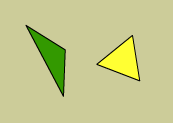Or search by topic
Number and algebra
Geometry and measure
Probability and statistics
Working mathematically
Advanced mathematics
For younger learners
Equal Equilateral Triangles



Imagine you have lots of copies of the two triangles pictured below:

You may wish to print off and cut out these Yellow and Green triangles.
-
Can you make a regular hexagon using only yellow triangles ?
-
Can you make a regular hexagon using only green triangles ?
-
Can you make a regular hexagon from yellow triangles that is the same size as a regular hexagon made from green triangles ?
Did that tell you something about yellow and green triangles, about how they relate to each other ?
- Can you make an equilateral triangle from yellow triangles ?
- Can you make an equilateral triangle from green triangles ?
- Can you make an equilateral triangle from yellow triangles that is the same size as an equilateral triangle made from green triangles ?
When you've got inside this problem and started to feel your way around, please do take a look at Impossible Triangles? - it's the perfect follow on. There's even a video to watch to make getting started easy.
Printable NRICH Roadshow resource.

